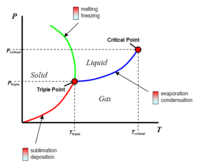Difference between revisions of "Terraforming"
(Gramar Fix) |
(Added a few methods of Terraforming) |
||
| Line 7: | Line 7: | ||
Presently, [[water|ice]] on Mars [[sublimation|sublimes]] as the atmospheric pressure is so low, ice bypasses the liquid phase when heated. Sublimation occurs allowing ice to turn directly into gas (steam). One of the main challenges for future terraforming efforts would be to increase the atmospheric pressure significantly so water can exist as a liquid on the surface of Mars. The atmospheric pressure will therefore need to be greater than the [[triple point]] of water (thereby existing as ice, liquid and gas). | Presently, [[water|ice]] on Mars [[sublimation|sublimes]] as the atmospheric pressure is so low, ice bypasses the liquid phase when heated. Sublimation occurs allowing ice to turn directly into gas (steam). One of the main challenges for future terraforming efforts would be to increase the atmospheric pressure significantly so water can exist as a liquid on the surface of Mars. The atmospheric pressure will therefore need to be greater than the [[triple point]] of water (thereby existing as ice, liquid and gas). | ||
| − | == | + | ==Methods== |
| + | A life supporting atmosphere needs to contain a "buffer gas", such as nitrogen. Mars is currently lacking in nitrogen, but nitrogen could be sourced from Venus, Saturn's moon Titan, or from comets. | ||
| + | Mars could be warmed up using greenhouse gases such as perflurocarbons, which are stable in the atmosphere for long periods of time. Mirrors could be placed in orbit to increase the amount of insolation Mars receives. | ||
| − | |||
==Long term prospect== | ==Long term prospect== | ||
| − | The ultimate results of terraforming are disputed. Terraforming may have only a temporary effect, even if the effect lasts for some hundred or thousand years. Eventually, the [[solar wind]] may carry away most of the new atmosphere due to the insufficient [[magnetosphere|magnetic field]]s of Mars | + | The ultimate results of terraforming are disputed. Terraforming may have only a temporary effect, even if the effect lasts for some hundred or thousand years. Eventually, the [[solar wind]] may carry away most of the new atmosphere due to the insufficient [[magnetosphere|magnetic field]]s of Mars. |
Revision as of 06:23, 18 June 2008
Terraforming, or Earth-shaping, is a theoretical process of modifying a planet's atmosphere to make it habitable for humans. In the case of Mars, terraforming would require artificial thickening of the atmosphere to intensify the process of greenhouse warming (heating the frozen landscape), ice melting to increase the H2O content of the atmosphere (creating water clouds) and greatly increasing the O2 density to ultimately make the atmosphere breathable.
Mars and the "Triple Point" of water

Presently, ice on Mars sublimes as the atmospheric pressure is so low, ice bypasses the liquid phase when heated. Sublimation occurs allowing ice to turn directly into gas (steam). One of the main challenges for future terraforming efforts would be to increase the atmospheric pressure significantly so water can exist as a liquid on the surface of Mars. The atmospheric pressure will therefore need to be greater than the triple point of water (thereby existing as ice, liquid and gas).
Methods
A life supporting atmosphere needs to contain a "buffer gas", such as nitrogen. Mars is currently lacking in nitrogen, but nitrogen could be sourced from Venus, Saturn's moon Titan, or from comets. Mars could be warmed up using greenhouse gases such as perflurocarbons, which are stable in the atmosphere for long periods of time. Mirrors could be placed in orbit to increase the amount of insolation Mars receives.
Long term prospect
The ultimate results of terraforming are disputed. Terraforming may have only a temporary effect, even if the effect lasts for some hundred or thousand years. Eventually, the solar wind may carry away most of the new atmosphere due to the insufficient magnetic fields of Mars.






